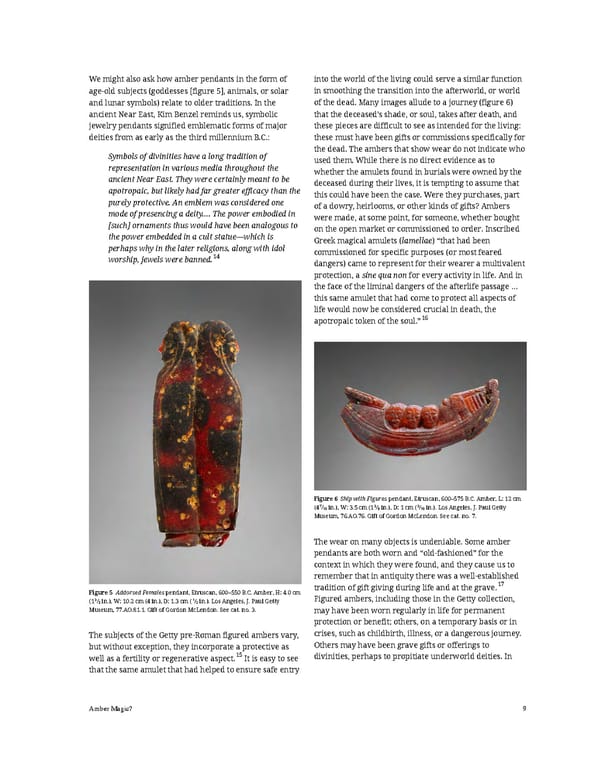We might also ask how amber pendants in the form of into the world of the living could serve a similar function age-old subjects (goddesses [figure 5], animals, or solar in smoothing the transition into the afterworld, or world and lunar symbols) relate to older traditions. In the of the dead. Many images allude to a journey (figure 6) ancient Near East, Kim Benzel reminds us, symbolic that the deceased’s shade, or soul, takes after death, and jewelry pendants signified emblematic forms of major these pieces are difficult to see as intended for the living: deities from as early as the third millennium B.C.: these must have been gifts or commissions specifically for the dead. The ambers that show wear do not indicate who Symbols of divinities have a long tradition of used them. While there is no direct evidence as to representation in various media throughout the whether the amulets found in burials were owned by the ancient Near East. They were certainly meant to be deceased during their lives, it is tempting to assume that apotropaic, but likely had far greater efficacy than the this could have been the case. Were they purchases, part purely protective. An emblem was considered one of a dowry, heirlooms, or other kinds of gifts? Ambers mode of presencing a deity.… The power embodied in were made, at some point, for someone, whether bought [such] ornaments thus would have been analogous to on the open market or commissioned to order. Inscribed the power embedded in a cult statue—which is Greek magical amulets (lamellae) “that had been perhaps why in the later religions, along with idol commissioned for specific purposes (or most feared worship, jewels were banned.14 dangers) came to represent for their wearer a multivalent protection, a sine qua non for every activity in life. And in the face of the liminal dangers of the afterlife passage … this same amulet that had come to protect all aspects of life would now be considered crucial in death, the apotropaic token of the soul.”16 Figure 6 Ship with Figures pendant, Etruscan, 600–575 B.C. Amber, L: 12 cm (47⁄10 in.), W: 3.5 cm (13⁄8 in.), D: 1 cm (3⁄10 in.). Los Angeles, J. Paul Getty Museum, 76.AO.76. Gift of Gordon McLendon. See cat. no. 7. The wear on many objects is undeniable. Some amber pendants are both worn and “old-fashioned” for the context in which they were found, and they cause us to remember that in antiquity there was a well-established tradition of gift giving during life and at the grave.17 Figure 5 Addorsed Females pendant, Etruscan, 600–550 B.C. Amber, H: 4.0 cm (13⁄5 in.), W: 10.2 cm (4 in.), D: 1.3 cm (1⁄2 in.). Los Angeles, J. Paul Getty Figured ambers, including those in the Getty collection, Museum, 77.AO.81.1. Gift of Gordon McLendon. See cat. no. 3. may have been worn regularly in life for permanent protection or benefit; others, on a temporary basis or in The subjects of the Getty pre-Roman figured ambers vary, crises, such as childbirth, illness, or a dangerous journey. but without exception, they incorporate a protective as Others may have been grave gifts or offerings to well as a fertility or regenerative aspect.15 It is easy to see divinities, perhaps to propitiate underworld deities. In that the same amulet that had helped to ensure safe entry Amber Magic? 9
 Ancient Carved Ambers in the J. Paul Getty Museum Page 18 Page 20
Ancient Carved Ambers in the J. Paul Getty Museum Page 18 Page 20